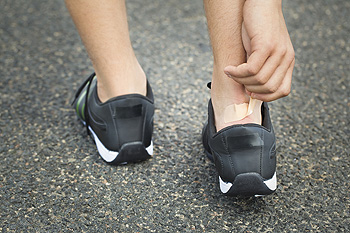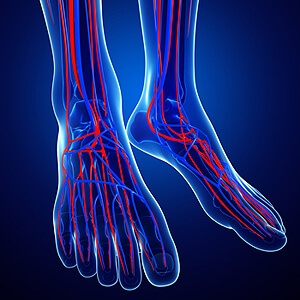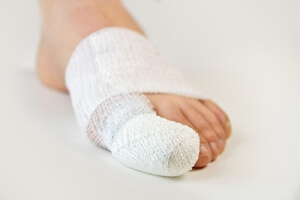Connect With Us
Featured Articles

Taking Care of Elderly Feet
Many foot diseases and conditions become more serious and common among the elderly. Some of these conditions include diabetic ulcers, ingrown toenails, fungus, arthritis, corns, and calluses. Unfortunately, it may be harder for older adults to take care of their own feet, but there are some precautions they can take in order to avoid any serious conditions.
Dry, cracked heels tend to be a common problem for older people. In order to avoid this, you should always keep your feet clean and well moisturized. Special feet moisturizers should be used as average lotions might not provide enough moisture for dry and cracked heels. Daily foot inspections are crucial for the elderly to detect any irregularities in their earliest stages. During the aging process, blood circulation tends to slow down causing older people to not feel their feet as well as they used to. This often results in foot problems going unnoticed.
Fungal and bacterial conditions thrive on elderly feet because older adults are less likely to keep their feet clean and dry; this makes it easier for bacteria to take hold in their dry, cracked skin. Elderly people should be sure to thoroughly dry their feet, especially in between the toes, after bathing. This will help them avoid developing any fungal infections. Additionally, clean cotton socks should be worn after the feet are dried.
Cutting toenails straight across will help prevent ingrown toenails. When toenails are cut too lose, the nail might break through the skin resulting in an ingrown nail. Clippers should be used to cut the nails in order to make the cut even.
Elderly people who have diabetes are at risk of developing serious foot problems that may lead to amputation. Ulcers that are left untreated can lead to gangrene. Dry and cracked feet, fungus, and untended cuts under the nails may also lead to infections.
Fortunately, Medicare covers many different types of services for foot care. Elderly people with any of these foot conditions should seek the help of a podiatrist and perform daily foot inspections in order to ensure that they have healthy feet.
Footwear and Ingrown Toenails
 Ingrown toenails are common and seem to randomly appear, but there are triggers that cause this uncomfortable condition. Wearing the wrong shoes is one of the triggers that may cause ingrown toenails. Shoes that are too tight around the toe area put pressure on the front of your foot and push your toes inward. High heels are a prime example of narrow-toed shoes that can cause foot complications. Running or similar physical activities also put you at a higher risk for ingrown toenails, because there is repetitive pressure being applied to the toenail. Wearing the right shoes while participating in these activities will lessen the likelihood of an ingrown nail. Shoes with a wide toe box paired with socks that don’t constrict the foot are the best option for physical activities. If you have an ingrown toenail and are concerned about it, then it is recommended you speak with a podiatrist to properly treat it.
Ingrown toenails are common and seem to randomly appear, but there are triggers that cause this uncomfortable condition. Wearing the wrong shoes is one of the triggers that may cause ingrown toenails. Shoes that are too tight around the toe area put pressure on the front of your foot and push your toes inward. High heels are a prime example of narrow-toed shoes that can cause foot complications. Running or similar physical activities also put you at a higher risk for ingrown toenails, because there is repetitive pressure being applied to the toenail. Wearing the right shoes while participating in these activities will lessen the likelihood of an ingrown nail. Shoes with a wide toe box paired with socks that don’t constrict the foot are the best option for physical activities. If you have an ingrown toenail and are concerned about it, then it is recommended you speak with a podiatrist to properly treat it.
Ingrown toenails may initially present themselves as a minor discomfort, but they may progress into an infection in the skin without proper treatment. For more information about ingrown toenails, contact one of our podiatrists of APEX Foot & Ankle Center. Our doctors can provide the care you need to keep you pain-free and on your feet.
Ingrown Toenails
Ingrown toenails are caused when the corner or side of a toenail grows into the soft flesh surrounding it. They often result in redness, swelling, pain, and in some cases, infection. This condition typically affects the big toe and may recur if it is not treated properly.
Causes
- Improper toenail trimming
- Genetics
- Improper shoe fitting
- Injury from pedicures or nail picking
- Abnormal gait
- Poor hygiene
You are more likely to develop an ingrown toenail if you are obese, have diabetes, arthritis, or have any fungal infection in your nails. Additionally, people who have foot or toe deformities are at a higher risk of developing an ingrown toenail.
Symptoms
Some symptoms of ingrown toenails are redness, swelling, and pain. In rare cases, there may be a yellowish drainage coming from the nail.
Treatment
Ignoring an ingrown toenail can have serious complications. Infections of the nail border can progress to a deeper soft-tissue infection, which can then turn into a bone infection. You should always speak with your podiatrist if you suspect you have an ingrown toenail, especially if you have diabetes or poor circulation.
If you have any questions, please feel free to contact our offices located in Fort Myers, Shellpoint, and Naples, FL . We offer the newest diagnostic and treatment technologies for all your foot care needs.
Ingrown Toenails
Ingrown toenails (onychocryptosis) are a common foot ailment and it is very unpleasant to experience. The condition is caused by an increase in pressure from the ingrowth of the nail edge into the skin of the toe. Ingrown toenails commonly cause pain in those who experience them. In some cases, the skin surrounding the ingrown toenail may break which may lead bacteria to enter through and cause an infection. Common symptoms of this ailment include pain, redness, swelling, and warmth around the toe.
An imbalance between the size of the nail and the enlargement of the nail skin edge causes ingrown toenails. This condition is often caused by improperly trimming the toenails. If you are trying you cut your nails, you should always try to trim straight across instead of in a rounded shape. Ingrown toenails can also be an inherited condition and they may also be caused by improper shoe fitting.
Another common cause of the condition is wearing shoes that are either too small or too large. Other causes include poor foot hygiene, obesity, diabetes, arthritis, edema, and fungal infections. There are many risk factors that may make a person more likely to develop an ingrown toenail. Athletes who play “stop and start” sports such as tennis, soccer, and basketball are most likely to have ingrown toenails.
People who have diabetes, a compromised immune system, or poor circulation should immediately seek care from a podiatrist if they have an ingrown toenail. It is also recommended to seek professional assistance if at-home remedies are not successful within a week or if there is persistent pain.
Should You Pop Your Blister?
 Blisters usually form on the back of the ankle and are a result of friction between your skin and your shoe. Depending on what caused the blister, blisters can be filled with a couple different fluids. These fluids include, plasma, blood, serum, and pus. These fluids are working to protect the skin and assist the body in the healing process. This is why you should never pop or break a blister, doing so will only stall the healing process. Also, opening up the blister and creating a wound puts you at a higher risk for infection. There are some instances when the blister should be drained, but this should be done by a medical professional. A doctor can use a sterile needle to drain the fluid and this is a much safer method. If you have a blister and think that it should be drained, then it is suggested you speak to a podiatrist in order to properly take care of it.
Blisters usually form on the back of the ankle and are a result of friction between your skin and your shoe. Depending on what caused the blister, blisters can be filled with a couple different fluids. These fluids include, plasma, blood, serum, and pus. These fluids are working to protect the skin and assist the body in the healing process. This is why you should never pop or break a blister, doing so will only stall the healing process. Also, opening up the blister and creating a wound puts you at a higher risk for infection. There are some instances when the blister should be drained, but this should be done by a medical professional. A doctor can use a sterile needle to drain the fluid and this is a much safer method. If you have a blister and think that it should be drained, then it is suggested you speak to a podiatrist in order to properly take care of it.
Blisters may appear as a single bubble or in a cluster. They can cause a lot of pain and may be filled with pus, blood, or watery serum. If your feet are hurting, contact one of our podiatrists of APEX Foot & Ankle Center. Our doctors can provide the care you need to keep you pain-free and on your feet.
Foot Blisters
Foot blisters are often the result of friction. This happens due to the constant rubbing from shoes, which can lead to pain.
What Are Foot Blisters?
A foot blister is a small fluid-filled pocket that forms on the upper-most layer of the skin. Blisters are filled with clear fluid and can lead to blood drainage or pus if the area becomes infected.
Symptoms
(Blister symptoms may vary depending on what is causing them)
- Bubble of skin filled with fluid
- Redness
- Moderate to severe pain
- Itching
Prevention & Treatment
In order to prevent blisters, you should be sure to wear comfortable shoes with socks that cushion your feet and absorb sweat. Breaking a blister open may increase your chances of developing an infection. However, if your blister breaks, you should wash the area with soap and water immediately and then apply a bandage to the affected area. If your blisters cause severe pain it is important that you call your podiatrist right away.
If you have any questions, please feel free to contact our offices located in Fort Myers, Shellpoint, and Naples, FL . We offer the newest diagnostic and treatment technologies for all your foot care needs.
Blisters
Blisters are pockets of fluid that occur under the top layer of your skin. These fluid pockets are usually filled with pus, blood, or serum. Blisters may itch or hurt and can appear as a single bubble or in clusters.
The most common types of blisters are friction blisters. This type of blister may be caused by wearing shoes that are too tight. Friction blisters can also occur on the hands. A change in temperature may also cause blisters on the feet. In the freezing air, frostbite on your toes can lead to blisters, as well as sunburn from hot weather.
The best way to treat a blister is to keep it clean and dry. Most blisters will get better on their own. Once the skin absorbs the fluid within the blister, it will flatten and eventually peel off. You should avoid popping your blister unless you podiatrist does it for you. Additional treatment options include applying an ice pack to the blister or using over-the-counter blister bandages to cover the affected area.
If your blister becomes discolored, inflamed, or worsens it is advised that you speak to your podiatrist. Blisters that are yellow, green, or purple may be infected and require immediate medical attention. Blisters that are abnormally colored may be a sign of a more serious underlying health condition such as herpes.
Symptoms of Poor Circulation
 Many people may experience poor circulation, and noticeable symptoms may be present in the feet. This condition may be a result of inadequate levels of oxygen and nutrients in the blood, which is normally pumped through blood vessels in the feet. There are many symptoms that are associated with poor circulation, and these may include a numbing sensation in the feet, coldness, and the skin color may appear to look pale blue or red. Patients may be aware of sores that have developed, and may have difficulty in healing properly, which may be a result of insufficient blood supply in the feet. Additionally, the toenails may grow slower than they usually do, and any hair that is present on the toes may not grow at all. If you are experiencing any symptoms relating to poor circulation in your feet, it is strongly advised to speak to a podiatrist as quickly as possible who can properly treat this condition.
Many people may experience poor circulation, and noticeable symptoms may be present in the feet. This condition may be a result of inadequate levels of oxygen and nutrients in the blood, which is normally pumped through blood vessels in the feet. There are many symptoms that are associated with poor circulation, and these may include a numbing sensation in the feet, coldness, and the skin color may appear to look pale blue or red. Patients may be aware of sores that have developed, and may have difficulty in healing properly, which may be a result of insufficient blood supply in the feet. Additionally, the toenails may grow slower than they usually do, and any hair that is present on the toes may not grow at all. If you are experiencing any symptoms relating to poor circulation in your feet, it is strongly advised to speak to a podiatrist as quickly as possible who can properly treat this condition.
While poor circulation itself isn’t a condition; it is a symptom of another underlying health condition you may have. If you have any concerns with poor circulation in your feet contact one of our podiatrists of APEX Foot & Ankle Center. Our doctors will treat your foot and ankle needs.
Poor Circulation in the Feet
Peripheral artery disease (PAD) can potentially lead to poor circulation in the lower extremities. PAD is a condition that causes the blood vessels and arteries to narrow. In a linked condition called atherosclerosis, the arteries stiffen up due to a buildup of plaque in the arteries and blood vessels. These two conditions can cause a decrease in the amount of blood that flows to your extremities, therefore resulting in pain.
Symptoms
Some of the most common symptoms of poor circulation are:
- Numbness
- Tingling
- Throbbing or stinging pain in limbs
- Pain
- Muscle Cramps
Treatment for poor circulation often depends on the underlying condition that causes it. Methods for treatment may include insulin for diabetes, special exercise programs, surgery for varicose veins, or compression socks for swollen legs.
As always, see a podiatrist as he or she will assist in finding a regimen that suits you. A podiatrist can also prescribe you any needed medication.
If you have any questions, please feel free to contact our offices located in Fort Myers, Shellpoint, and Naples, FL . We offer the newest diagnostic and treatment technologies for all your foot care needs.
Causes, Symptoms, and Treatment of Poor Blood Circulation in the Feet
Poor blood circulation in the feet and legs is often caused by peripheral artery disease (PAD), which is usually the result of a buildup of plaque in the arteries. Plaque buildup, or atherosclerosis, can be the result of excess calcium and cholesterol in the bloodstream. This restricts how much blood can flow through arteries. Reduced blood flow to a certain area of the body severely limits the amount of oxygen and nutrients that part of the body receives. This leads to degeneration in the muscles and other tissues. Sometimes, poor blood circulation in the feet and legs can be caused by other conditions, such as the damaging or inflammation of blood vessels, known as vasculitis.
The lack of oxygen and nutrients caused by poor blood circulation can restrict muscle growth and development, as well as cause muscle pain and cramps, weakness, and stiffness. Other common symptoms include numbness in the legs and feet, skin discoloration in the affected limbs, slower nail and hair growth, and erectile dysfunction in men. In more severe cases of PAD, pain can be present even when a person isn't exercising, and may range from mildly uncomfortable to completely debilitating.
Poor blood circulation in the feet and legs is more common in those who are overweight or obese, have diabetes, high blood pressure, high cholesterol, who smoke, or who have a family history of PAD or related conditions such as a heart attack, stroke, etc. Diabetes and smoking place a person at greatest risk for developing poor blood circulation, although advanced age, over 50, can also increase risk.
If you are experiencing poor blood circulation in the feet and legs caused by PAD, it is important to make changes to your lifestyle in order to reduce your risk of experiencing a heart attack or stroke caused by this condition. If you smoke, quit completely. This will increase the amount of oxygen in your bloodstream. Exercising and reducing the saturated fats in your diet. Saturated fats come from fatty meats, fried foods, whole milk, etc., can make a difference in improving blood circulation in feet. It is also important to avoid developing influenza and to carefully control your blood sugar if you have diabetes.
Your doctor may recommend combining lifestyle changes with a prescription medication regimen to improve blood circulation. The most commonly-used medications for PAD are called statins and work by blocking the amount of enzymes in your body that produce cholesterol. They are known by the brand names Zocor, Lipitor, Crestor, and others.
Causes of Broken Toes
 The bones that are located in the toes are fragile and small. A broken toe may be a result if it has been severely stubbed or if a heavy object has been dropped on it. Some of the noticeable symptoms that can be felt may be severe pain while walking, in addition to swelling and bruising. Mild relief may be found while staying off your foot, which may help to ease the pain. Many patients find the swelling may diminish as a result of elevating their foot. Stability may be found when the toe is taped to the one next to it, and this may make it easier to walk. When comfortable shoes are worn, which may include choosing footwear that have a stiff sole and adequate room for the toes to move freely in, a level of comfort may be obtained. If the fracture involves the big toe or severe pain is experienced in the other toes, it is suggested to consult with a podiatrist who can perform a correct diagnosis and begin the proper treatment.
The bones that are located in the toes are fragile and small. A broken toe may be a result if it has been severely stubbed or if a heavy object has been dropped on it. Some of the noticeable symptoms that can be felt may be severe pain while walking, in addition to swelling and bruising. Mild relief may be found while staying off your foot, which may help to ease the pain. Many patients find the swelling may diminish as a result of elevating their foot. Stability may be found when the toe is taped to the one next to it, and this may make it easier to walk. When comfortable shoes are worn, which may include choosing footwear that have a stiff sole and adequate room for the toes to move freely in, a level of comfort may be obtained. If the fracture involves the big toe or severe pain is experienced in the other toes, it is suggested to consult with a podiatrist who can perform a correct diagnosis and begin the proper treatment.
A broken toe can be very painful and lead to complications if not properly fixed. If you have any concerns about your feet, contact one of our podiatrists from APEX Foot & Ankle Center. Our doctors will treat your foot and ankle needs.
What to Know About a Broken Toe
Although most people try to avoid foot trauma such as banging, stubbing, or dropping heavy objects on their feet, the unfortunate fact is that it is a common occurrence. Given the fact that toes are positioned in front of the feet, they typically sustain the brunt of such trauma. When trauma occurs to a toe, the result can be a painful break (fracture).
Symptoms of a Broken Toe
- Throbbing pain
- Swelling
- Bruising on the skin and toenail
- The inability to move the toe
- Toe appears crooked or disfigured
- Tingling or numbness in the toe
Generally, it is best to stay off of the injured toe with the affected foot elevated.
Severe toe fractures may be treated with a splint, cast, and in some cases, minor surgery. Due to its position and the pressure it endures with daily activity, future complications can occur if the big toe is not properly treated.
If you have any questions please feel free to contact our offices located in Fort Myers, Shellpoint, and Naples, FL . We offer the newest diagnostic and treatment technologies for all your foot and ankle needs.
What to Know About a Broken Toe
The forefoot is composed of five metatarsal bones and fourteen phalanges. Each toe has three phalanges except for the big toe which only has two. Our toes play an essential role to the walking process, which is why a broken toe could seriously disrupt one’s ability to move around. Toe fractures are common and can be very painful. Fortunately, these injuries rarely require surgery and usually heal with rest and a change in activity.
Broken toes typically result from a traumatic event such as falling, stubbing the toe, or dropping something on the toe. Traumatic toe fractures may be categorized as either minor or severe fractures. At times, one may hear a “pop” or “crack” sound when the bone breaks. Common symptoms of a traumatic toe fracture include pain, throbbing, bruising, swelling, and redness.
Another type of toe fractures is a stress fracture. These injuries usually appear in the form of small hairline breaks on the bone. Stress fractures develop after repetitive activity instead of a single injury. Stress fractures occur when the muscles in the bone become too weak to absorb impact. Consequently, the toe bone becomes vulnerable to any pressure and impact it endures. Symptoms for a stress fracture in the toe include swelling without bruising, tenderness to the touch, pain that goes away with rest, and pain after walking or running.
If you suspect that you have a broken toe, you should make an appointment with your podiatrist. He or she will likely diagnose you by performing a physical exam and an X-ray. Treatment for a broken toe may include the R.I.C.E. method, buddy taping, surgery, or antibiotics. The R.I.C.E. method (Rest, Ice, Compression, and Elevation) is a common treatment method for many injuries because it decreases pain. Buddy tapping involves wrapping the injured toe next to an adjacent toe to keep it supported and protected. These two methods have proven to be effective in the healing process for toe fractures. The estimated healing time for a broken toe is approximately four to six weeks. If the injury becomes infected or requires surgery, the estimated healing time may take eight weeks or more.
Symptoms of Stress Fractures
 The definition of a stress fracture are tiny cracks in the bone that are a result of repeated stress that is placed on the foot. These activities may include running, jumping, or dancing. They may also develop if there are existing medical conditions, such as arthritis or osteoporosis. An early symptom that is associated with stress fractures is pain occurring during an activity that may diminish upon resting. As the stress fracture worsens, the pain and discomfort may be felt for the majority of the time, and may be felt in a specific area of the foot. After a proper diagnosis is performed which generally includes having an MRI or bone scan taken, the correct treatment can begin. This may include resting the foot, in addition to taking anti-inflammatory medications. If you feel you have incurred a stress fracture, it is suggested to consult with a podiatrist who can offer correct treatment options.
The definition of a stress fracture are tiny cracks in the bone that are a result of repeated stress that is placed on the foot. These activities may include running, jumping, or dancing. They may also develop if there are existing medical conditions, such as arthritis or osteoporosis. An early symptom that is associated with stress fractures is pain occurring during an activity that may diminish upon resting. As the stress fracture worsens, the pain and discomfort may be felt for the majority of the time, and may be felt in a specific area of the foot. After a proper diagnosis is performed which generally includes having an MRI or bone scan taken, the correct treatment can begin. This may include resting the foot, in addition to taking anti-inflammatory medications. If you feel you have incurred a stress fracture, it is suggested to consult with a podiatrist who can offer correct treatment options.
Stress fractures occur when there is a tiny crack within a bone. To learn more, contact one of our podiatrists from APEX Foot & Ankle Center. Our doctors can provide the care you need to keep you pain free and on your feet.
How Are They Caused?
Stress fractures are the result of repetitive force being placed on the bone. Since the lower leg and feet often carry most of the body’s weight, stress fractures are likely to occur in these areas. If you rush into a new exercise, you are more likely to develop a stress fracture since you are starting too much, too soon. Pain resulting from stress fractures may go unnoticed at first, however it may start to worsen over time.
Risk Factors
- Gender – They are more commonly found in women compared to men.
- Foot Problems – People with unusual arches in their feet are more likely to develop stress fractures.
- Certain Sports – Dancers, gymnasts, tennis players, runners, and basketball players are more likely to develop stress fractures.
- Lack of Nutrients – A lack of vitamin D and calcium may weaken the bones and make you more prone to stress fractures
- Weak Bones – Osteoporosis can weaken the bones therefore resulting in stress fractures
Stress fractures do not always heal properly, so it is important that you seek help from a podiatrist if you suspect you may have one. Ignoring your stress fracture may cause it to worsen, and you may develop chronic pain as well as additional fractures.
If you have any questions, please feel free to contact our offices located in Fort Myers, Shellpoint, and Naples, FL . We offer the newest diagnostic and treatment technologies for all your foot care needs.
Featured Articles
- May 2025
- April 2025
- March 2025
- February 2025
- January 2025
- December 2024
- November 2024
- October 2024
- September 2024
- August 2024
- July 2024
- June 2024
- May 2024
- April 2024
- March 2024
- February 2024
- January 2024
- December 2023
- November 2023
- October 2023
- September 2023
- August 2023
- July 2023
- June 2023
- May 2023
- April 2023
- March 2023
- February 2023
- January 2023
- December 2022
- November 2022
- October 2022
- September 2022
- August 2022
- July 2022
- June 2022
- May 2022
- April 2022
- March 2022
- February 2022
- January 2022
- December 2021
- November 2021
- October 2021
- September 2021
- August 2021
- July 2021
- June 2021
- May 2021
- April 2021
- March 2021
- February 2021
- January 2021
- December 2020
- November 2020
- October 2020
- September 2020
- August 2020
- July 2020
- June 2020
- May 2020
- April 2020
- March 2020
- February 2020
- January 2020
- December 2019
- November 2019
- October 2019
- September 2019
- August 2019
- July 2019
- June 2019
- May 2019
- April 2019
- March 2019
- February 2019
- January 2019
- December 2018
- November 2018
- October 2018
- September 2018
- August 2018
- July 2018
- June 2018
- May 2018
- April 2018
- March 2018
- February 2018
- January 2018
- December 2017
- November 2017
- October 2017
- September 2017
- August 2017
- July 2017
- June 2017
- May 2017
- April 2017
- March 2017
- February 2017
- January 2017
- December 2016
- November 2016
- October 2016
- September 2016
- August 2016
- July 2016
- June 2016
- May 2016
- April 2016
- March 2016
- February 2016
- January 2016




